
The Fayette County Courthouse is a government building in Vandalia, the county seat of Fayette County, Illinois, United States. Converted from a residence in the 1930s, it succeeded a former state capitol as the courthouse for Fayette County.

The Fayette County Courthouse is a government building in Vandalia, the county seat of Fayette County, Illinois, United States. Converted from a residence in the 1930s, it succeeded a former state capitol as the courthouse for Fayette County.
The initial capital of Illinois was Kaskaskia on the Mississippi River, but the first years of statehood saw the center of population gradually move northward, [1] : 12 and in 1819 the legislature decreed the creation of a new capital along the Kaskaskia River in Bond County, in the center of the state. Named Vandalia, the city was platted by the end of 1820; eastern Bond County was split off into the new Fayette County in early 1821, and Vandalia was declared the county seat. A small log building was soon erected on the site and used both by the legislature and the new county, but this state of affairs ceased when the building was destroyed by fire. It was later replaced by a brick structure, [1] : 13 while county offices rented spaces in an assortment of buildings. [2]
By the mid-1830s, continued northern migration had prompted calls for the capital to be relocated farther north, [2] and the meager quality of the brick capitol provided further arguments for those advocating relocation. Afraid to lose their status as capital, a group of Vandalia residents built a new capitol building for the state in 1836, but legislators nevertheless chose to move north to Springfield. No longer needing the building, the state gave the property to the county for courthouse purposes in 1839. The state bought back the courthouse in 1918, but it remained in county use until 1933, when the state began to restore it for museum use. [3]
Born in Hannover in the early nineteenth century, Frederick Remann emigrated to the United States, where he married and fathered a son, future state representative Frederick Remann II, and moved his family to Vandalia. Father and son together operated a local business, which was prosperous enough to permit Remann (whether father or son is uncertain) to build a mansion west of central Vandalia in the 1860s or 1870s. Although it began as an example of the Italianate style, the house lost its grand tower between 1878 and 1904, the arcade supporting the front porch was eventually replaced with pairs of columns, and a two-story bay window was reduced to the first story only. [4]
With the state planning to convert the courthouse into a museum, Fayette County officials purchased the former Remann House in 1932 and began remodelling it for their own purposes; offices moved into the new courthouse in the following year. As the twentieth century passed, the Remann House gradually became too small for the county's needs, so several adjacent buildings were purchased or constructed. These arrangements also proving inconvenient, the county embarked on another construction project; when work concluded in 1995, the county complex had been converted into a single large connected building, although elements of the Remann design survive, including the bay window, the porch, and much of the basic form of the house. [2]

Clinton County is located in the U.S. state of Illinois. At the 2020 census, the population was 36,899. Its county seat is Carlyle.

Fayette County is a county located in the U.S. state of Illinois. As of the 2020 census, the population was 21,488. Its county seat is Vandalia, the site of the Vandalia State House State Historic Site. Ramsey Lake State Recreation Area is located in the northwestern part of this county.

Carlyle is a city in Clinton County, Illinois, United States. The population was 3,253 at the 2020 census. It is the county seat of Clinton County.
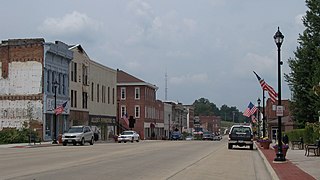
Vandalia is a city in and the county seat of Fayette County, Illinois, United States. At the 2020 Census, the population was 7,458. Vandalia is on the Kaskaskia River, and 60 miles (97 km) northeast of the St. Louis area. The city served as the state capital of Illinois from 1819 until 1839, when the seat of state government moved closer to the center of the state in Springfield. In the early 19th century, Vandalia was the western terminus of the National Road from the East Coast. Since 1933, the Vandalia State House State Historic Site has sought to preserve and interpret the State House building and grounds, originally constructed in 1836.

Kaskaskia is a village in Randolph County, Illinois. Having been inhabited by indigenous peoples, it was settled by France as part of the Illinois Country. It was named for the Kaskaskia people. Its population peaked at about 7,000 in the 18th century, when it was a regional center. During the American Revolutionary War, the town, which by then had become an administrative center for the British Province of Quebec, was taken by the Virginia militia during the Illinois campaign. It was designated as the county seat of Illinois County, Virginia, after which it became part of the Northwest Territory in 1787. Kaskaskia was later named as the capital of the United States' Illinois Territory, created on February 3, 1809. In 1818, when Illinois became the 21st U.S. state, the town briefly served as the state's first capital until 1819, when the capital was moved to more centrally located Vandalia.
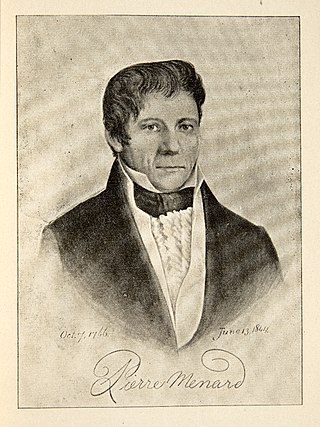
Pierre Menard was a Canadian-American fur trader and U.S. political figure who was elected the first lieutenant Governor of Illinois in 1818.

The Illinois State Capitol, located in Springfield, Illinois, houses the legislative and executive branches of the government of the U.S. state of Illinois. The current building is the sixth to serve as the capitol building since Illinois was admitted to the United States in 1818. Built in the architectural styles of the French Renaissance and Italianate, it was designed by Cochrane and Garnsey, an architecture and design firm based in Chicago. Ground was broken for the new capitol on March 11, 1868, and the building was completed twenty years later for a total cost of $4.5 million.
The Illinois Historic Preservation Division, formerly Illinois Historic Preservation Agency, is a governmental agency of the U.S. state of Illinois, and is a division of the Illinois Department of Natural Resources. It is tasked with the duty of maintaining State-owned historic sites, and maximizing their educational and recreational value to visitors or on-line users. In addition, it manages the process for applications within the state for additions to the National Register of Historic Places.
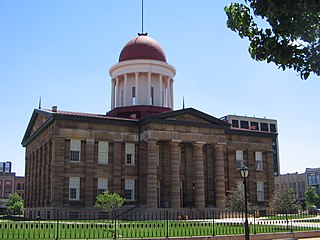
The Old State Capitol State Historic Site, in Springfield, Illinois, is the fifth capitol building built for the U.S. state of Illinois. It was built in the Greek Revival style in 1837–1840, when Springfield became the capital city, and served as the state house from 1840 to 1876. It is the site of candidacy announcements by Abraham Lincoln in 1858 and Barack Obama in 2007. It was designated a National Historic Landmark in 1961, primarily for its association with Lincoln and his political rival Stephen Douglas.

The Vandalia State House, built in 1836, is the fourth capitol building of the U.S. state of Illinois. It is also the oldest capitol building in Illinois to survive, as the first, second, and third capitol buildings have all disappeared. The brick Federal style state house has been operated by the state of Illinois as a monument of Illinois' pioneer years since 1933. It is located in Vandalia, Illinois, on the National Road, and listed on the National Register of Historic Places.
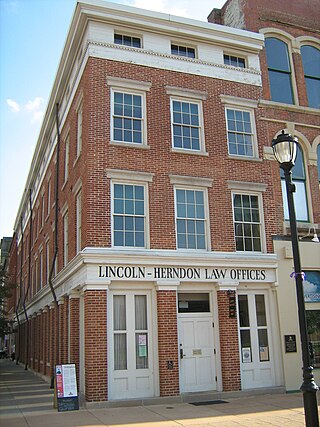
The Lincoln-Herndon Law Offices State Historic Site is a historic brick building built in 1841 in the U.S. state of Illinois. It is located at 6th and Adams Streets in Springfield, Illinois. The law office has been restored and is operated by the Illinois Historic Preservation Agency as a state historic site.

Little Brick House is a restored 1860s middle-class home in Vandalia, Illinois, located in Fayette County. The home is the only house in Vandalia to be listed on the National Register of Historic Places. It has been listed as such since 1973.
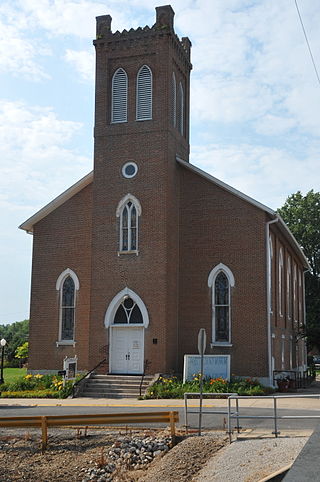
The First Presbyterian Church is a museum and former Presbyterian church located at 301 W. Main St. in Vandalia, Illinois. The church was built in 1868 on the site of the first Protestant church in Illinois. The first church at the site, the House of Divine Worship, was a non-denominational church built in 1823 by the Illinois State Legislature; at the time, Vandalia was the state capital, and the governor's house was located next to the church. The Presbyterian church, built after the state capital moved to Springfield, was designed in the Gothic Revival style. The red brick church has a 60-foot (18 m) tall bell tower. The church has twelve Gothic pointed arch windows; each window has an oval stained glass pattern depicting a religious scene. Vandalia's Presbyterian congregation left the building for a new church in the 1960s, and the building is now used as the Fayette County Museum.
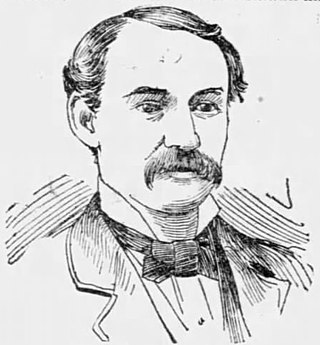
Frederick Remann was an Illinois Republican politician. He was a member of the Illinois House of Representatives and was also elected from Illinois to the United States House of Representatives.

The Pierre Menard House, located in Ellis Grove, Illinois, United States, was the home of Pierre Menard, a trader who became the first lieutenant governor of Illinois from 1818 to 1822.
Lytleville is an unincorporated community in McLean County, Illinois, United States, located south of Bloomington-Normal, and is approximately 3½ miles northeast of Heyworth in Randolph Township. The community was laid out by John Baldwin in 1836, around his sawmill. Baldwin named the town after a friend, Robert T. Lytle, a Democrat who was a U.S. Congressman from Ohio from 1833 to 1835.

The Cherokee National Capitol, now the Cherokee Nation Courthouse, is a historic tribal government building in Tahlequah, Oklahoma. Completed in 1869, it served as the capitol building of the Cherokee Nation from 1869 to 1907, when Oklahoma became a state. It now serves as the site of the tribal supreme court and judicial branch. It was designated a National Historic Landmark in 1961 for its role in the Nation's history.
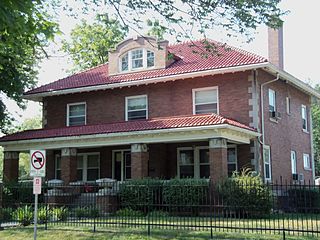
The Arthur Ebeling House is a historic building located on the west side of Davenport, Iowa, United States. The Colonial Revival house was designed by its original owner, Arthur Ebeling. It was built from 1912 to 1913 and it was listed on the National Register of Historic Places in 1984.

The St. Clair County Courthouse is a government building in Belleville, the county seat of St. Clair County, Illinois, United States. Built in 1976, it is the fifth courthouse in the history of the county, and one of two that still stands.